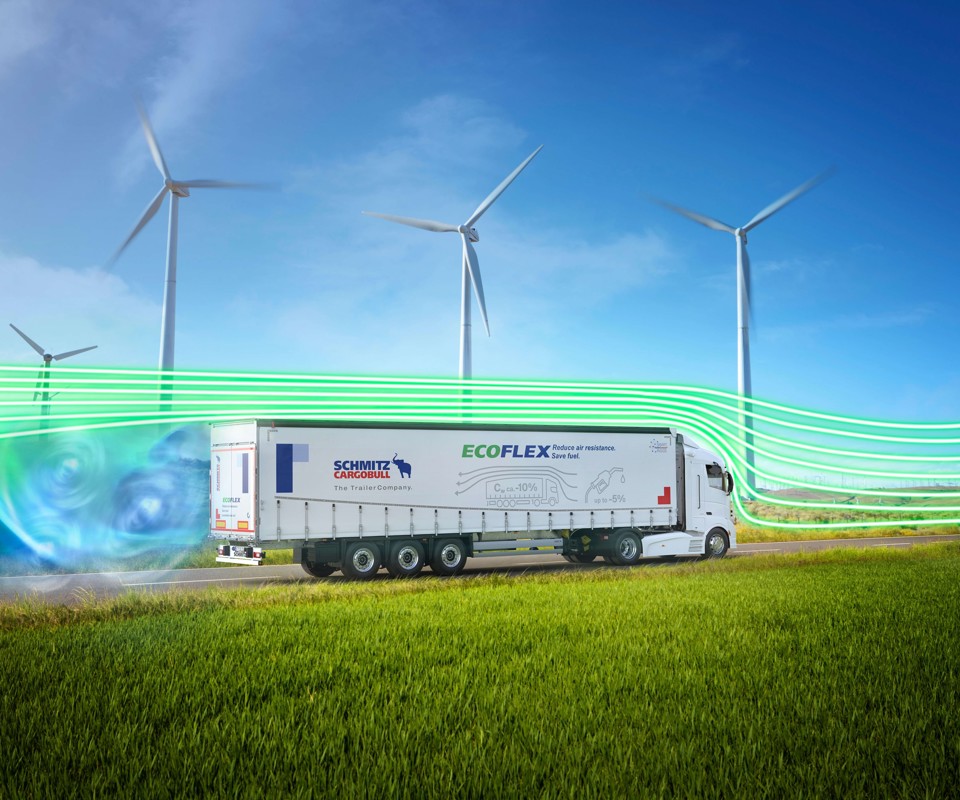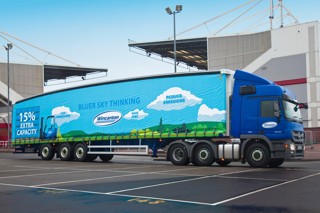Fuel savings of up to 5% could be enjoyed by fleets that opt for Schmitz Cargobull’s new line-up of aerodynamic curtainsider tri-axle semi-trailers, claims the manufacturer.
The EcoGeneration trio includes models with roofs that can be lowered to reduce aerodynamic drag if the cargo does not reach the ceiling or if the trailer is running empty.
Cover 150,000km (93,206 miles) a year for four years with the roof lowered 30% of the time and the drop in fuel consumption could save ¤3,190 (£2,838), the company contends. CO2 output should shrink by 6.7 tonnes.
Lower the roof for 50% of the time over the same mileage and time scale and you should save ¤5,320 (£4,733), with an 11-tonne CO2 cut. Increase to 70% and the savings could be ¤7,450 euros (£6,629) and 15.6 tonnes, although you might consider whether you actually need a small vehicle to improve utilisation.
The rearmost section of the EcoFlex trailer’s roof can be lowered by 500mm from a maximum internal height of 2,700mm. The trailers have an overall height of four metres.
With the EcoVarios model, both the front and rear sections of the body can be flexibly adjusted. The maximum interior height of 3,000mm can be reduced 400mm.
Both trailers are fitted with a hydro-pneumatic pump used to raise the roof. Altering the height takes around 10 minutes including adjusting the curtains.
EcoFlex is designed for general cargo and beverage transport while EcoVarios can be used for bulky loads. It can handle pallet cages stacked three high.
The third option is EcoFix. With a fixed aerodynamic roof, it can be used to haul heavy cargo such as steel which sit low on the trailer, well below its ceiling.
In this case, the maximum internal height is 2,650mm declining to 2,200mm at the back.
The 5% fuel saving figure quoted could be an underestimate in certain cases, suggests Schmitz chief technical officer Roland Klement. “In field tests we’ve had some customers report reductions of 8% or more,” he said.
The company believes the same concept could be applied to curtainsider bodies designed for rigid chassis longer term.
One of Europe’s biggest trailer builders, Schmitz declined to disclose how much more the newcomers will cost than the standard S.CS models on which they are based. Volume production will start during the second quarter.
EcoGeneration has its origins in the Transformers programme.
A ¤7.9m (£7m) research initiative aimed at cutting CO2 output, it was backed by Schmitz Cargobull, Volvo, Daf and a number of other companies as well as research institutes. Completed around three years ago, it was endorsed by the European Commission.
The Transformers trailer that emerged featured side skirts and so-called boat tails - fins projecting 500mm from the rear - along with a roof whose height could be altered. It all added up to a potential 9.2% cut in fuel consumption and CO2 emissions.
The difficulty with skirts and fins is that they are at far greater risk of being dented and cracked accidentally than the roof. The cost of repairing such damage has to be weighed against any savings they may deliver.
“Our EcoGeneration trailers don’t have any costly attachments that break easily,” remarked chief executive officer, Andreas Schmitz.
Equipping semi-trailers with aerodynamic roofs is not a new idea. British trailer builders have been doing so for several years, as Klement readily concedes.
Trailers designed solely for use in the UK are not subject to an overall height limit, however, which gives aerodynamic specialists considerable scope when it comes to devising dramatically-effective designs. Most other European countries impose a four-metre height limit and the same restriction is imposed on trailers used on cross-border work.



















Login to comment
Comments
No comments have been made yet.